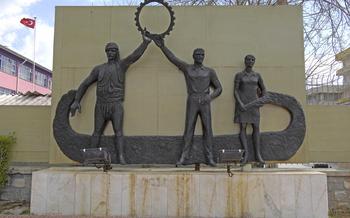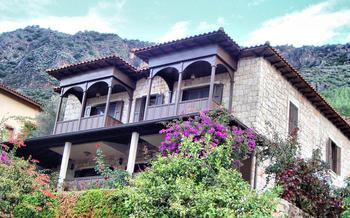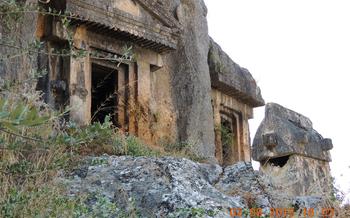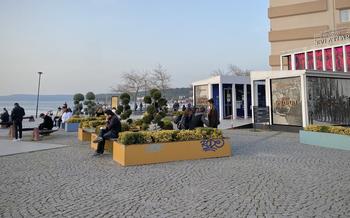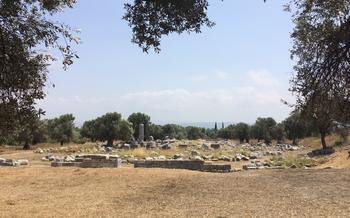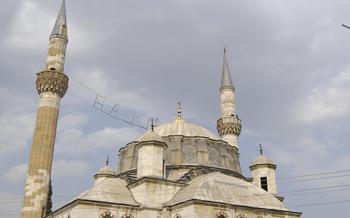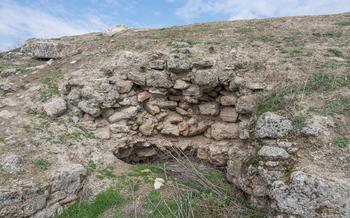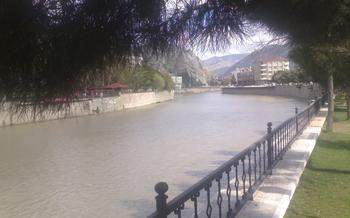
Kızılkaya Ancient City
- Kızılkaya Ancient City: A Journey Through History
- Unveiling the Ruins: A Walk Through Time
- The Lycian Legacy: Exploring the Ancient Civilization
- The Agora: Echoes of Ancient Commerce
- The Odeon: A Stage for Ancient Performances
- The Acropolis: Atop the Ancient City
- The Bath Complex: A Haven of Relaxation
- The Necropolis: A Realm of Eternal Rest
- The Cistern: A Hidden Reservoir
- The Byzantine Church: A Glimpse of Christian Heritage
- The Ottoman Legacy: Traces of a Bygone Era
- The Museum: A Treasure Trove of Artifacts
- The Enchanting Surroundings: Natural Wonders Await
- Insider Tip: Unveiling the Hidden Gem
Kızılkaya Ancient City: A Journey Through History
Historical significance Embark on a journey through time as you step into the ancient city of Kızılkaya, nestled amidst the picturesque landscapes of Isparta, Turkey. This city, with its rich and storied past, dates back to the 4th century BC, serving as a significant settlement during the Lycian, Roman, and Byzantine periods. As you explore the ruins of Kızılkaya, you'll uncover a treasure trove of historical wonders, shedding light on the lives and cultures of civilizations that once thrived here.
Archaeological discoveries Over the years, archaeological excavations at Kızılkaya have unearthed a wealth of artifacts, providing valuable insights into the city's past. From intricately carved sculptures to remnants of grand temples, these discoveries offer a glimpse into the artistry and craftsmanship of ancient civilizations. Among the most remarkable finds are the well-preserved mosaics and frescoes, which depict scenes from mythology, daily life, and religious rituals, bringing the history of Kızılkaya vividly to life.
Legends and myths In the tapestry of Kızılkaya's history, legends and myths intertwine with factual accounts, adding an air of enchantment to the city's allure. One captivating legend speaks of a beautiful young woman named Kızılkaya, whose tragic love story is said to have given the city its name. As you wander through the ancient streets, let your imagination wander, and you might just catch a glimpse of Kızılkaya's spirit, forever entwined with the city's destiny.
Unveiling the Ruins: A Walk Through Time
As you step through the ancient city's gates, you'll be greeted by a labyrinth of imposing walls, weathered by time and whispering tales of a bygone era. Explore the ruins of temples and religious structures, where deities were once worshipped and sacrifices were offered. Marvel at the grandeur of public buildings and marketplaces, where the hustle and bustle of commerce once filled the air. Each stone, each fragment bears witness to the rich history that unfolds before your eyes, inviting you on a journey through the ages.
The Lycian Legacy: Exploring the Ancient Civilization
The ancient city of Kızılkaya bears witness to the rich history and culture of the Lycians, an Anatolian civilization that flourished in the region during the 1st millennium BC. The Lycians were known for their unique language, art, and architecture, leaving an indelible mark on the cultural landscape of ancient Turkey.
Lycian History and Culture
The Lycians emerged as a distinct civilization around the 8th century BC, inhabiting the southwestern coast of Anatolia, including the area where Kızılkaya is located. They were skilled mariners and traders, establishing a network of commercial and cultural connections throughout the Mediterranean. The Lycians also developed a sophisticated political system, with a league of cities that governed the region.
Lycian Architecture and Art
Lycian architecture is characterized by its distinctive blend of Greek and Anatolian influences. The city walls of Kızılkaya, for example, showcase the use of massive stone blocks, reminiscent of Mycenaean fortifications. Lycian temples, such as the one dedicated to Apollo, feature intricate carvings and sculptures, reflecting the influence of Greek artistic traditions.
Lycian Inscriptions and Funerary Monuments
The Lycians were skilled in writing, using a unique alphabet that has been partially deciphered. Numerous inscriptions found in Kızılkaya provide valuable insights into Lycian history, religion, and daily life. Lycian funerary monuments, such as the elaborate rock-cut tombs, are also a testament to their artistic prowess and belief in an afterlife.
The Agora: Echoes of Ancient Commerce
The agora, the bustling marketplace of Kızılkaya, stood as the economic heart of the ancient city. Its layout and design reflected the vibrant commercial activities that once took place within its confines. The agora was strategically situated at the intersection of major roads, ensuring a steady flow of traders and customers.
The marketplace was lined with shops and stalls, each catering to a specific trade or craft. Merchants displayed their wares, from locally produced pottery and textiles to imported goods from distant lands. The air was filled with the sounds of bargaining, the clinking of coins, and the hum of social interactions.
Archaeological excavations have unearthed a wealth of artifacts from the agora, providing valuable insights into the economic activities of Kızılkaya. These finds include coins, pottery fragments, and inscriptions that shed light on the types of goods traded, as well as the economic relationships between Kızılkaya and other settlements in the region.
The agora was not merely a place of commerce but also a social and cultural hub. It served as a meeting place for citizens to exchange news, discuss politics, and engage in leisurely activities. Festivals and celebrations were often held in the agora, bringing the community together in shared experiences.
As you walk through the ruins of the agora, let your imagination transport you back in time to the bustling marketplace of ancient Kızılkaya. Picture the lively interactions between merchants and customers, the sounds of haggling, and the vibrant energy that permeated this vibrant commercial center.
The Odeon: A Stage for Ancient Performances
The odeon, a smaller version of the theater, served as an intimate venue for musical performances, recitals, and poetry readings in ancient Kızılkaya. It is a remarkable example of Lycian architecture, showcasing their expertise in acoustics and design.
The odeon's well-preserved structure features a circular orchestra, a raised stage, and concentric rows of stone seats that can accommodate up to 500 spectators. The seating arrangement ensures excellent sightlines and acoustics, allowing the audience to fully immerse themselves in the performances.
The odeon was not only a place of entertainment but also a hub for cultural and intellectual exchange. It hosted a variety of events, including musical concerts, poetry recitals, and dramatic performances. The versatility of the space allowed for different artistic expressions and fostered a vibrant cultural scene in Kızılkaya.
The Acropolis: Atop the Ancient City
The acropolis, the fortified citadel of the ancient city of Kızılkaya, stands as a testament to the city's strategic importance and military prowess. Perched atop a hill overlooking the surrounding landscape, the acropolis provided an unparalleled vantage point for monitoring potential threats and maintaining control over the region. Its formidable walls, constructed from massive stone blocks, served as a protective barrier, ensuring the safety and security of the city's inhabitants.
Within the confines of the acropolis, a cluster of temples and shrines dedicated to various deities held a prominent position. These sacred structures, adorned with intricate carvings and colorful frescoes, served as places of worship and religious rituals for the city's population. The most notable among them was the Temple of Apollo, a magnificent edifice dedicated to the sun god, whose towering columns and imposing facade commanded awe and reverence.
Ascending to the summit of the acropolis rewarded visitors with breathtaking panoramic views of the surrounding countryside. The fertile plains stretched out below, dotted with fields, orchards, and villages, while the distant mountains formed a majestic backdrop. The panoramic vista offered a glimpse into the natural beauty and agricultural wealth of the region, further emphasizing Kızılkaya's strategic significance as a regional hub.
The Bath Complex: A Haven of Relaxation
Amidst the ruins of Kızılkaya, the bath complex stands as a testament to the ancient city's dedication to hygiene and leisure. Designed with intricate precision, the baths were a sanctuary where residents could unwind, socialize, and rejuvenate their bodies and minds.
The layout of the complex showcases a harmonious blend of functionality and aesthetics. At its heart lies the frigidarium, a cold plunge pool that braced bathers before they ventured into the tepidarium, a warm room that gradually raised their body temperature. The pièce de résistance was the caldarium, a hot room fueled by a sophisticated hypocaust system that circulated hot air beneath the floors and walls, creating a steamy and invigorating environment.
Bathing rituals were an integral part of daily life in Kızılkaya. Before entering the baths, visitors would typically undress in the apodyterium, a changing room equipped with benches and lockers. They would then proceed to the frigidarium for a bracing dip, followed by a visit to the tepidarium to warm up. The highlight of the bathing experience was undoubtedly the caldarium, where bathers could relax their muscles, soothe their minds, and indulge in invigorating steam baths.
The bath complex was adorned with exquisite mosaics and frescoes that depicted scenes of mythology, nature, and everyday life. These vibrant artworks not only enhanced the aesthetic appeal of the baths but also offered a glimpse into the artistic sensibilities and cultural influences of the ancient city.
Today, the bath complex stands as a testament to the ingenuity and craftsmanship of the ancient Lycians. Its well-preserved mosaics and frescoes offer a fascinating glimpse into the bathing rituals and cultural practices of a bygone era, making it a must-see attraction for any visitor to Kızılkaya.
The Necropolis: A Realm of Eternal Rest
The ancient city of Kızılkaya is home to an extensive necropolis, a city of the dead that holds the remains of its former inhabitants. The Lycians, who once called this place home, had distinct burial customs and rituals that set their necropolis apart.
Lycian Burial Customs and Rituals
The Lycians believed in the afterlife and prepared their dead for their journey into the next world. They practiced cremation, burning the bodies of their deceased loved ones on funeral pyres. The ashes were then collected and placed in urns or buried in elaborate tombs.
Types of Tombs and Their Significance
The Lycian necropolis showcases a variety of tomb types, each carrying its own significance. Rock-cut tombs, carved into the natural rock formations, are among the most common. These tombs feature intricate carvings and decorations, often depicting scenes from mythology or daily life.
Intricate Carvings and Decorations
The tombs in the Kızılkaya necropolis are adorned with an array of carvings and decorations that offer a glimpse into the Lycian worldview. These include depictions of gods and goddesses, mythical creatures, and scenes from daily life. The carvings often showcase the exceptional craftsmanship and artistry of the Lycian people.
The Cistern: A Hidden Reservoir
In the heart of Kızılkaya's bustling ancient city, a hidden marvel lies beneath the surface - the cistern. This remarkable structure served as a vital lifeline for the city's inhabitants, ensuring a steady supply of water for domestic use, irrigation, and public fountains.
Constructed with meticulous precision, the cistern is a testament to the engineering prowess of ancient civilizations. Its vaulted ceilings and sturdy walls, composed of massive stone blocks, have stood the test of time, preserving this subterranean treasure for centuries.
Descending into the cistern is like stepping into a secret chamber, revealing a cool and humid atmosphere. The water level, though now diminished, once reached several meters, providing an ample reserve for the city's needs.
The cistern's design showcased a sophisticated understanding of water management. A series of channels and pipes, some still visible today, channeled water from nearby springs and rainwater into the reservoir. This intricate system ensured a continuous flow of fresh water, vital for the city's survival and prosperity.
The cistern served not only a practical purpose but also held cultural and religious significance. Water held a sacred place in ancient societies, associated with purity, fertility, and divine blessings. The cistern, as the heart of the city's water supply, likely played a role in religious rituals and ceremonies.
Today, the cistern stands as a testament to the ingenuity and resourcefulness of the ancients. Its well-preserved state offers a glimpse into the daily lives of Kızılkaya's inhabitants, showcasing their mastery of water management and their deep connection to this precious resource.
The Byzantine Church: A Glimpse of Christian Heritage
In the heart of Kızılkaya, amidst the ruins of ancient civilizations, stands a testament to the enduring legacy of Christianity - the Byzantine Church. Erected during the Byzantine Empire's reign, this sacred edifice narrates the tale of a transformative era when Christianity took root, leaving an indelible mark on the region's religious landscape.
With its distinctive architectural style, the church captivates visitors with its intricate stonework, arched doorways, and domed roof. Inside, the walls are adorned with vibrant frescoes and mosaics, depicting biblical scenes with remarkable artistry. These exquisite artworks offer a glimpse into the spiritual beliefs and practices of the Byzantine era.
The Byzantine Church stands as a poignant reminder of the profound impact Christianity had on Kızılkaya and the surrounding region. It invites visitors to delve into the rich history of religious devotion and cultural exchange that shaped this ancient city.
The Ottoman Legacy: Traces of a Bygone Era
The arrival of the Ottomans in the 15th century marked a new chapter in Kızılkaya's history. Although the city's significance had waned by this time, it still held strategic importance due to its location on trade routes. The Ottomans constructed several buildings and fortifications, leaving their mark on the ancient city.
One of the most notable Ottoman structures is the caravanserai, a large inn used by traders and travelers. The caravanserai features a central courtyard surrounded by rooms for guests and animals. It served as a resting point for caravans traveling along the trade routes, providing shelter, food, and water.
Another Ottoman legacy is the mosque, built during the 16th century. The mosque features a simple yet elegant design, with a prayer hall, a minaret, and a courtyard. It is a testament to the religious and cultural influence of the Ottomans in the region.
In addition to these structures, the Ottomans also left behind inscriptions and other artifacts that provide insights into their rule. These inscriptions often commemorate the construction of buildings or the appointment of officials. They offer valuable information about the administrative and social structures of the Ottoman period.
The Ottoman legacy in Kızılkaya is a reminder of the city's rich and varied history. While the ancient ruins may be the main attraction, the Ottoman structures and artifacts offer a glimpse into a later chapter in Kızılkaya's story.
The Museum: A Treasure Trove of Artifacts
Within the confines of Kızılkaya, a treasure trove of artifacts awaits discovery at the local museum. This repository of ancient wonders houses a diverse collection of relics excavated from the city's storied past. Pottery shards, intricately carved sculptures, and weathered inscriptions narrate the tale of a civilization that thrived in this very land.
Among the museum's prized possessions are ceramic vessels that once graced Lycian tables, their surfaces adorned with intricate motifs and patterns. These remnants of daily life offer a glimpse into the culinary practices and artistic sensibilities of the city's inhabitants.
Equally captivating are the sculptures that adorn the museum's halls. From imposing statues of deities to delicate figurines depicting scenes from mythology, these works of art provide a tangible connection to the spiritual beliefs and artistic prowess of the Lycians.
The museum's collection of inscriptions, etched in stone and metal, serves as a testament to the written legacy of Kızılkaya. These inscriptions, ranging from official decrees to personal dedications, shed light on the administrative, political, and social structures that governed this ancient city.
A visit to the museum is an essential complement to any exploration of Kızılkaya. Within its walls, the echoes of history reverberate, inviting visitors to delve deeper into the lives and culture of a civilization that left an indelible mark on the tapestry of the ancient world.
The Enchanting Surroundings: Natural Wonders Await
Beyond the ancient ruins of Kızılkaya, the surrounding landscapes offer a tapestry of natural wonders. Picturesque vistas, verdant hills, and idyllic hiking trails invite adventurous souls to explore the region's hidden gems.
Eğirdir Lake: A shimmering jewel nestled amidst towering mountains, Eğirdir Lake beckons with its crystal-clear waters and tranquil shores. Embark on a scenic boat tour to discover secluded coves, charming islands, and hidden beaches. Immerse yourself in the serenity of this natural paradise, where time seems to stand still.
Davraz Mountain: For those seeking a more active adventure, Davraz Mountain beckons with its challenging slopes and breathtaking panoramas. Lace up your hiking boots and embark on a journey through lush forests, alpine meadows, and rugged terrain. As you ascend, the views become increasingly awe-inspiring, rewarding your efforts with vistas that stretch for miles.
Outdoor Activities: The region surrounding Kızılkaya is a haven for outdoor enthusiasts. Whether you prefer leisurely strolls along scenic paths or adrenaline-pumping mountain biking trails, there's something for every adventurer. Explore the diverse ecosystems, encounter local wildlife, and create lasting memories in the embrace of nature.
Insider Tip: Unveiling the Hidden Gem
-
Best time to visit: Kızılkaya is a year-round destination, but the best time to visit is during the shoulder seasons (April-May and October-November) when the weather is mild and pleasant. Summer months can be hot and dry, while winters can be cold and snowy.
-
Local festivals and events: To immerse yourself in the local culture, plan your visit to coincide with one of the many festivals and events held in Isparta throughout the year. The Eğirdir Mesir Macunu Festival in May celebrates a traditional Turkish delight made with 41 different spices. The Davraz Mountain Festival in July offers outdoor activities, traditional music, and local cuisine.
-
Recommended tour guides: For a deeper exploration of Kızılkaya, consider hiring a local tour guide. They can provide insights into the history, culture, and legends of the ancient city, making your visit even more enriching. Look for guides who are licensed and knowledgeable, and who can cater to your specific interests.
